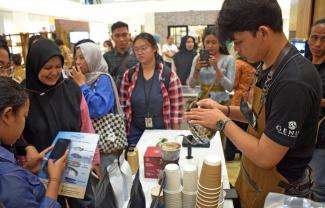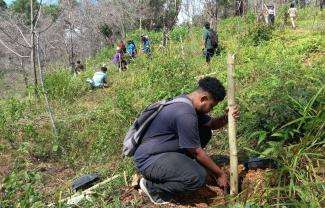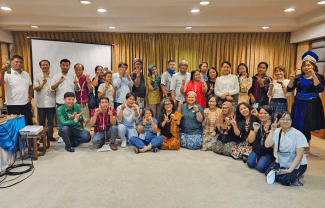Writing about activities should flow to attract readers so they can understand how each activity progresses, Readers are invited to understand the substance of the matter and how the solutions respond to each challenge. The readers may be inspired and will be more likely support the sustainability of the activity by giving feedbacks.
In this context, Samdhana is asking its partners to write a story from the village'. The objective of this activity is to change the verbal storytelling habit into a non-verbal storytelling habit in the forms of writing and drawing.
This activity does not emphasize on rules for writing an activity report. The story from the village writing activity is one of the attempts of correcting the notion of writing complexity and finding the solution.
The activity involved 18 people of 13 villagers from Air Naningan and 5 staff from Way Seputih Conservation Foundation. They casually enjoyed the learning process and practised writing together on Writing A Village Story' (10-14 October 2014).
The participants ranging from 19 to 65 years old. These villagers are mostly members of Koperasi Tirto Kencana, which was officially established on February 2014.
“Previously, I didn't write well. This is the first time I feel that writing is important for the future. I can share stories about village to my kids and grandkids one day, said Mbah Sangkrah, 65-year old, one of the participants who is also one of the founders of Koperasi Tirto Kencono.
Mbah Sangkrah came to Lampung in 1983. He was originally from Gunung Kidul, Yogyakarta. His land belonged to someone else which he bought after 3 years of cultivating the land and profit sharing. With his determination, he managed to transform bushes into productive land.
By writing a story about his village, Mbah Sangkrah has documented his life journey in a memoir, including a story about his 0.5 ha land that was being affected from Batu Tegi dam in 1987. He used the compansation of Rp50,000 to buy 0.25 ha of land. Mbah Sangkrah also witnessed his land drowning and many other villagers' of Air Naningan in 1993 when Batu Tegi was being dammed and officiated by former President Megawati 10 years later.
“In 2004, we made 3 boats. We use them when want to go to the land. Every day, me and seven others go to the land together because not everyone can row.
The same story is told by Alfian Ahmad, a 19-year old man from Talang 20 Village. He was working in an IT company in Palembang, South Sulawesi. He then decided to go back to his hometown to go into farming. In his opinion, there are many potentials and richness of Air Naningan that can be managed and better processed. Years ago, Air Naningan was left behind in terms of infrasctructure but today it is progressing and positively impacts the local economy.
The Batu Tegi dam is now used as a power plant, tourist attraction, and agriculture to produce coffee, pepper, clove, bananas, coconuts and many more.
“Through writing, what we have can create a lot of opportunities; from Curug Tujuh tourism to packaged coffee.
Participants from the writing a story from village' activity are divided into two discussion groups. The first group is of people who were directly involved in Ecosystem Alliance (EA) in Air Naningan and wrote about condition on their farmers institutions and Koperasi Tirto Kencono. The other group is made of other villagers who give contextual backgrounds on Air Naningan in general, including its potential and challenges. In total, there are 31 articles from participants which were uploaded to EA Indonesia blog.




